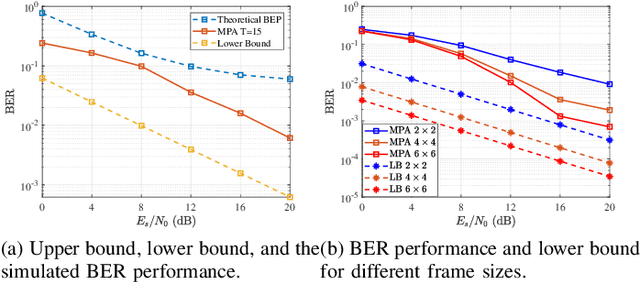Tantao Gong
Performance Analysis of OAMP Detection for ODDM Modulation in Satellite Communications
Jun 24, 2025

Abstract:Towards future 6G wireless networks, low earth orbit (LEO) satellites have been widely considered as a promising component to enhance the terrestrial communications. To ensure the link reliability of high-mobility satellite communication scenarios, the emerging orthogonal delay-Doppler division multiplexing (ODDM) modulation has attracted significant research attention. In this paper, we study the diversity gain achieved by ODDM modulation along with the mathematical analysis and numerical simulations. Additionally, we propose an orthogonal approximate message passing (OAMP) algorithm based detector to harvest the diversity gain promised by ODDM modulation. By operating the linear and non-linear estimator iteratively, the orthogonal approximate message passing (OAMP) detector can utilize the sparsity of the effective delay-Doppler (DD) domain channel and extract the full diversity. Simulation results reveal the relationship between diversity gain and system parameters, and demonstrate that our proposed detector can achieve better performance than the conventional message passing methods with significantly reduced complexity.
OTFS vs OFDM: Which is Superior in Multiuser LEO Satellite Communications
Mar 04, 2024



Abstract:Orthogonal time frequency space (OTFS) modulation, a delay-Doppler (DD) domain communication scheme exhibiting strong robustness against the Doppler shifts, has the potentials to be employed in LEO satellite communications. However, the performance comparison with the orthogonal frequency division multiplexing (OFDM) modulation and the resource allocation scheme for multiuser OTFS-based LEO satellite communication system have rarely been investigated. In this paper, we conduct a performance comparison under various channel conditions between the OTFS and OFDM modulations, encompassing evaluations of sum-rate and bit error ratio (BER). Additionally, we investigate the joint optimal allocation of power and delay-Doppler resource blocks aiming at maximizing sum-rate for multiuser downlink OTFS-based LEO satellite communication systems. Unlike the conventional modulations relaying on complex input-output relations within the Time-Frequency (TF) domain, the OTFS modulation exploits both time and frequency diversities, i.e., delay and Doppler shifts remain constant during a OTFS frame, which facilitates a DD domain input-output simple relation for our investigation. We transform the resulting non-convex and combinatorial optimization problem into an equivalent difference of convex problem by decoupling the conditional constraints, and solve the transformed problem via penalty convex-concave procedure algorithm. Simulation results demonstrate that the OTFS modulation is robust to carrier frequency offsets (CFO) caused by high-mobility of LEO satellites, and has superior performance to the OFDM modulation. Moreover, numerical results indicate that our proposed resource allocation scheme has higher sum-rate than existed schemes for the OTFS modulation, such as delay divided multiple access and Doppler divided multiple access, especially in the high signal-to-noise ratio (SNR) regime.
A Framework for Mutual Information-based MIMO Integrated Sensing and Communication Beamforming Design
Nov 15, 2022Abstract:Integrated sensing and communication (ISAC) unifies sensing and communication, and improves the efficiency of the spectrum, energy, and hardware. In this work, we investigate the ISAC beamforming design to maximize the mutual information between the target response matrix of a point radar target and the echo signals, while ensuring the data rate requirements of communication users. In order to study the impact of the echo interference caused by communication users on sensing performance, we consider three types of echo interference problems caused by a single communication user, including no interference, a point interference, and an extended interference, as well as the problem of an extended interference caused by multiple communication users. To address these problems, we provide a closed-form solution with low complexiy, a semidefinite relaxation (SDR) method, a low-complexity algorithm based on the Majorization-Minimization (MM) method and the successive convex approximation (SCA) method, and an algorithm based on MM method and SCA method, respectively. Numerical results demonstrate that, compared to the ISAC beamforming schemes based on the Cram\'er-Rao bound (CRB) metric and the beampattern metric, the proposed maximizing mutual information metric can bring better beampattern and root mean square error (RMSE) of angle estimation. Apart from this, our proposed schemes based on the mutual information can suppress the echo interference from the communication users effectively.
 Add to Chrome
Add to Chrome Add to Firefox
Add to Firefox Add to Edge
Add to Edge